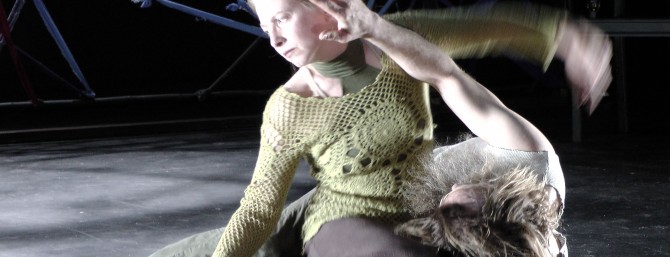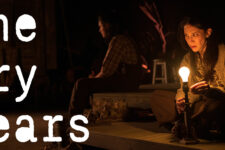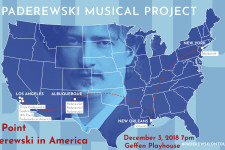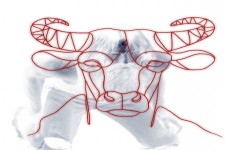by LISA DRING
One should be prepared for anything when going to see a show at The Ghost Road Company. There could be an intricate set, with walls of movable glass wheeled about and drawn on in a tightly bound drama, as in their 2013/14 production The Bargain and the Butterfly. The audience could walk into a room full of chairs and a few lamps, and wait as those few set pieces come so distinctly alive in 80 minutes, as was the case in the spring showing of Asterion. Or one could witness what is largely an exploration of bodies in movement, with sparse prose tying the whole thing together, as is sometimes shared in a Ghost Road project’s initial public showing.
The company is currently preparing to mount the next iteration of Asterion, a play inspired by the myth of the Minotaur, which will be presented on November 19 and 20 at the Getty Villa as part of their Villa Theater Lab series. In the production, a soldier leaves the monstrosities of war to return to his family, yet is tortured by his beast inside. His internal struggle, along with a thread of forbidden love, tilt the dynamics of his home to a toppling point. In this version of the piece, the company is looking to further its exploration of an ensemble’s potential; its goal is to achieve a deeper level of communication than that which they’ve experienced together onstage. And they travelled all the way to Europe to help them find that new depth.
Ghost Road has brought productions to Poland before, often creating a Polish-centered play here and then sharing it across the pond. This summer, the company traveled to train with Teatr ZAR artists Aleksandra Kotecka and Tomasz Wierzbowski over the course of two weeks. In doing so, they began adding new vocal and instrumental music to the piece, but were also aiming to reach a level of rigor — of group listening and attention — that they only have found in European work.
Ghost Road’s trust in and dedication to the ensemble is apparent in both the plays they choose and how they’re performed. (They describe their company as both a working cohort and a chosen family.) Los Angeles is home to a slew of ensembles, most of which contain anywhere from a dozen to fifty members. Ghost Road is a seven-person group, most of whom have been with the company for years. They invite collaborators in, but even their guest artists often create with Ghost Road for a year or two at a time on a single play. They hold several workshops and invite audiences to attend multiple times before premiering a piece; Asterion ran earlier this spring, as well as in 2015, and won’t receive its official world premiere until next year. You may wonder: how much deeper into a play and an ensemble can you get?
Artistic Director Katharine Noon is not one for settling, and sees the next level in the Polish ensemble model. She believes that the U.S. theatre-making structure just doesn’t allow for the kind of creation that Europeans can achieve. Part of this, she explains, is due to the economic support provided by the governments of many other countries — the so-called budgetary ‘Candylands’ that theatre companies in Germany, France, or Australia have access to. (The NEA’s 2016 budget, for example, was $148 million, while Germany’s culture budget is equivalent to over $1.4 billion.) Some people would blame this disparity in arts funding on America’s capitalist free-market society. What Noon also points out is how a country’s fiscal prioritization of art, or lack thereof, reveals how important theatre is for that culture.
“We go back [to Poland] because theatre is important there. There, it’s central to expression, it’s central to getting through history, and everybody goes to the theatre. It doesn’t matter what kind of theatre it is — from experimental work to whatever — theatre-makers are important to the culture, whereas in LA, theatre-makers are not as important.”
That’s a heavy statement. But in the current climate of Los Angeles theatre, where some companies will be forced to close down if they have to pay actors minimum wage for rehearsal and performance time, it’s hard to disagree. The sense of juggling, when many artists are rushing to rehearsal after day jobs, affects not only how many hours that can be devoted to art-making, but how much energy can be spared while still having some left over to figure out how to pay the bills. And when artists do get paid a living wage to make theatre, it’s usually on a project-by-project basis, often with three weeks to prepare a show for opening.
The actors of Teatr ZAR, and many other Polish companies, are salaried by the government as a devising ensemble. The sheer amount of time artists have with one another allows them to create in a completely different way than Americans do. “When we went to Poland,” says Noon, “I brought the script and [Teatr ZAR] said ‘Oh, it’s so exciting to have a script!’— because they tend to work scriptless.” Noon explains that the Polish actors didn’t need the text to be written down because “they work eight, ten hours a day, and they just absorb [the language]. It’s the same thing with learning the music — people learn the music by ingesting it.”
She continues, “[Americans] are unable, because how our world is structured, to have that depth of interaction. It’s like that Grotowski idea of getting past your own brain into pure creation. There’s never enough hours in the typical rehearsal day to get through that membrane, so you do the best you can at that level. But when we worked with [Teatr ZAR] we were literally singing ten hours a day. And at a certain point, you get past yourself and into another realm that you can’t experience any other way.”
This is not to say that Ghost Road doesn’t find inspiration from American companies. “The Network of Ensemble Theaters, especially in the early days, really influenced us in how those companies worked [by finding] a consensus, and a communal way of working that’s not dictatorial but, at the same time, has leadership,” says Noon. She also cites SITI company, and her alma mater, CalArts, as instrumental in developing her creative technique. And yet, the company returns to Poland year after year because, well, it works. Noon says that the outcome of this most recent trip was that it changed how the company focuses within its performances. “There’s more intensity of attention paid.”
Ghost Road travels across the Atlantic so its performers can sing and listen to each other for ten hours at a time. That temporal, fiscal, and energetic cost is more than most companies can support, but this organization values it enough — and wills it hard enough — to make it happen. Such commitment to the ensemble’s process reveals a fundamental (and perhaps rare) belief held by Noon and Ghost Road artists: theatre is not about a thing being created, but a group in the act of creation.
ASTERION, by The Ghost Road Company at The Getty Villa: November 19 & 20.
![]() Returning from a sort of exile, battle weary Asterion faces a strange homecoming full of veiled intentions and twisted familial bonds. In this world of shadows, he must face his demons as those closest to him fan the flames of his monstrousness.
Returning from a sort of exile, battle weary Asterion faces a strange homecoming full of veiled intentions and twisted familial bonds. In this world of shadows, he must face his demons as those closest to him fan the flames of his monstrousness.









0 Comment